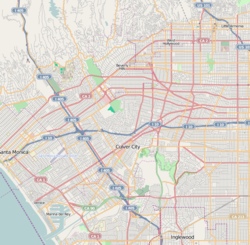Hollywood Heights, Los Angeles
| Hollywood Heights | |
|---|---|
| Neighborhood of Los Angeles | |
| Location within Western Los Angeles | |
| Coordinates: 34°06′29″N 118°20′33″W / 34.108136°N 118.34258°W | |
| Country | United States |
| State | California |
| County | Los Angeles |
| City | Los Angeles |
| District | Hollywood Hills |
| ZIP code(s) | 90068 |
| Area code(s) | 323 |
Hollywood Heights is a neighborhood in the Hollywood Hills of Los Angeles, bounded by the Hollywood Bowl on the north, Highland Avenue on the east, Outpost Estates on the west, and Franklin Avenue on the south. It includes a number of notable historic homes and buildings and has been home to numerous people in the film and music industries, dating back to the silent film era.
Located in what was the northern part of the Rancho La Brea Mexican land grant in the 19th century, H.J. Whitley developed the neighborhood as early as 1902 as part of his Hollywood-Ocean View Tract.
The Samuel Freeman House (1962 Glencoe Way) was designed by Frank Lloyd Wright, supervised by Lloyd Wright, and furnished and expanded by Rudolph Schindler. Built in 1923, it is one of four textile block houses built by Frank Lloyd Wright in Los Angeles between 1922 and 1924, and it has the world's first glass-to-glass corner windows. It was known as an avant-garde salon, and the list of individuals who spent significant periods of time there or lived in the house's two Schindler-designed apartments includes John Bovingdon, Beniamino Bufano, Xavier Cugat, Rudi Gernreich, Martha Graham, Philip Johnson, Peter Krasnow, Bella Lewitzky, Jean Negulesco, Richard Neutra, Claude Rains, Herman Sachs, Galka Scheyer, Edward Weston, Olga Zacsek, and Fritz Zwicky. It also served as an intellectual sanctuary for individuals blacklisted by the House Un-American Activities Committee. It is on the National Register of Historic Places.
...
Wikipedia

